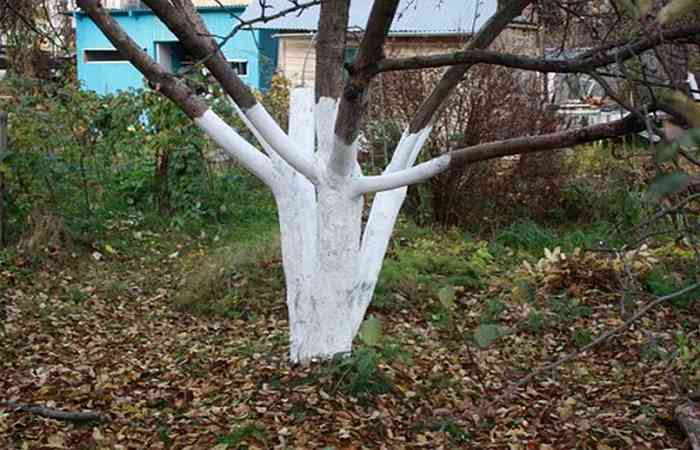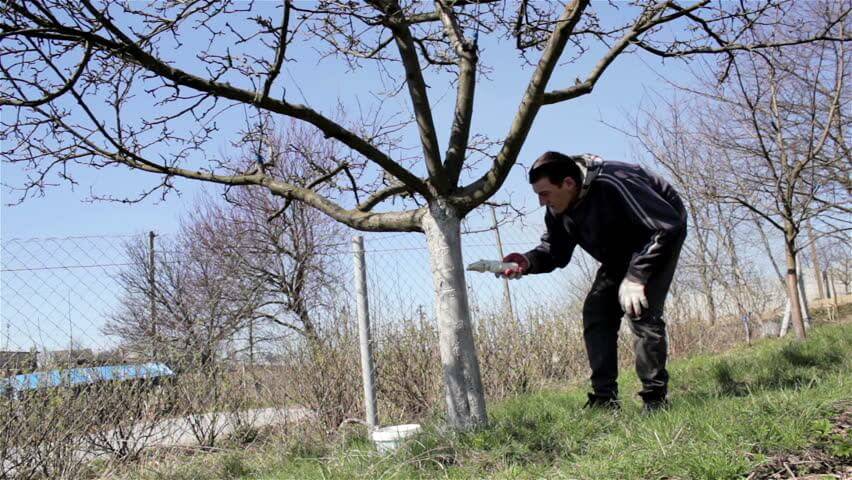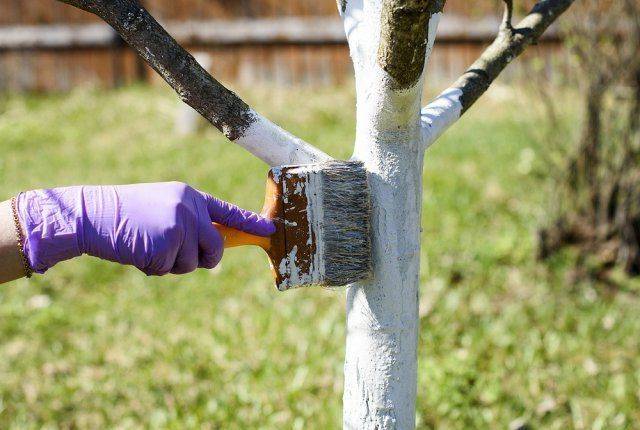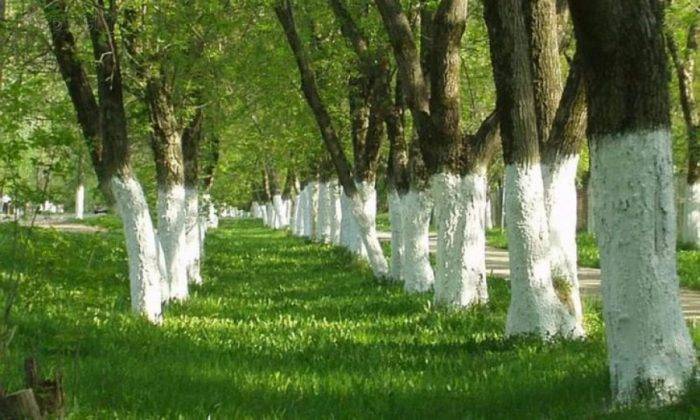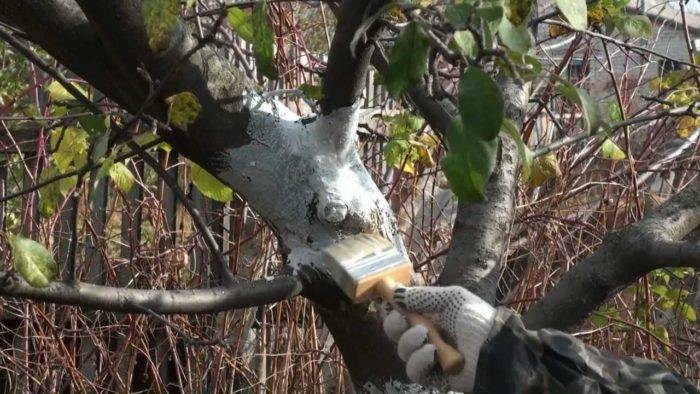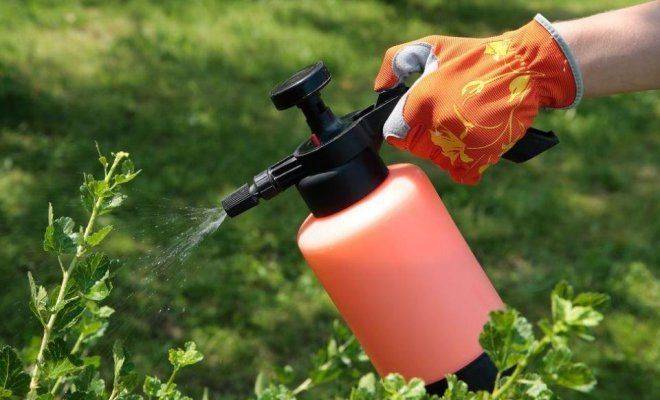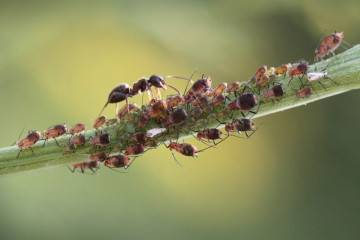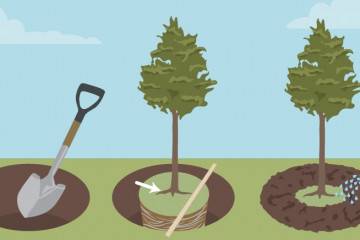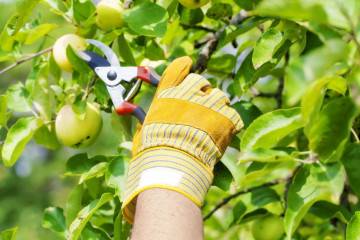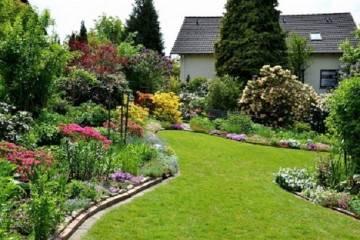Whitewashing trees in spring - treating fruit trees from pests
Content:
For many years, for most people, the whitewashing of trees in the spring is directly related to the traditional subbotniks. What is its role and how to properly approach this seemingly simple procedure?
All about whitewashing trees in spring
Why are trees whitewashed? The bark plays an important role in the life of a plant, it protects its internal tissues from mechanical damage, as well as negative effects from a number of other negative factors. These include temperature fluctuations, winds, insects and rodents that settle around. It is easy to guess that this is why the main function of whitewashing is protective. In particular:
- during periods when the tree is deprived of natural protection in the form of foliage (in autumn and early spring), it protects the trunk from bark burns;
- destroys the larvae of harmful insects inside the bark;
- prevents the appearance of microcracks on the surface of the bark.
Why are tree trunks under 5-6 years old whitewashed and is it really necessary? This issue has caused a lot of controversy for several years. Could the mixture used cause a burn on the thin bark and stop its growth?
In fact, the probability of deformation of the bark under the influence of the composition of the mixture used in the process is quite probable, however, this risk can be minimized by reducing the concentration of lime in it. In addition, as an alternative to a mixture containing aggressive components, you can use a silver biomask, water-based paint or acrylic.
When to whitewash trees
To achieve an optimal result, whitewashing of trees is carried out three times a year at the specified time:
- the first whitewashing, which is also the most important, is performed in the fall from September to November;
- the second time - in late February or early March;
- once again the whitewash update is carried out in July.
Why are trees whitewashed and why exactly on such a schedule? Such measures are explained by the fact that the first days of February and the beginning of March are considered the most dangerous. During this period, the trunk heats up enough so that during the daytime sap flows inside it, and at night, when the air temperature drops, the liquid freezes. This increases the risk of tearing of internal tissues and the appearance of microcracks.
The white color of the mixture is not accidental: it effectively repels the sun's rays and does not allow the temperature inside the tree to heat up above necessary. Due to the fact that the plant treated in this way wakes up a little later. It will also be protected from spring frosts.
If a tree (less often a shrub) could not be defeated in due time, it is permissible to do it for the first time in February, without waiting for April. Then the benefits of the procedure will be negligible. In this case, the second whitewashing can be carried out in the spring at any time, and the summer one may not be carried out at all, if the previous layer is still holding.
How to whitewash tree trunks
What is the best way to whitewash trees? Each mixture has its own pros and cons. Lime is easy to use for whitewashing because it is environmentally friendly and relatively inexpensive, and easy to sprinkle. Nevertheless, it also has many disadvantages, in particular, it has low durability. After two or three serious rains, it will be washed away. It also has very little protection against pests and rodents. Of course, this problem can be partially solved by introducing a little copper sulfate into the composition, but this will complicate the whitewashing process and make it more expensive. And, as noted above, it is unlikely to be suitable for processing young plants.
Is it possible to whitewash trees with water-based paint
Water-based paint as an independent tool can also be used for whitewashing because it also provides the bark with protection from burns and the effects of temperature changes. Unlike lime, it holds up much better.
White for trees
It is also perfectly acceptable to use acrylic paints for whitewashing. They are resistant, contain components that effectively protect against insects, as well as various diseases. Another advantage of the paint is that it does not allow the inner tissues to lose water, but at the same time it allows air to pass through. However, the cost of acrylic paints is higher than analogues.
How to dilute lime to whitewash trees
To minimize the risk that the whitewash will wash off after one or two rains, it is important to choose the mixture responsibly. Better to give preference to water-based or acrylic paint. Its durability is higher than that of lime. Or carry out the first whitewashing in winter (at the end of February).
Before using quicklime for whitewashing, it must be extinguished. To do this, lime is poured from the package into a bucket and filled with water (for 3 kg of lime, about 8-10 liters of water will be needed). As a result, the lime begins to boil, and the container in which it is located, heats up. Extinction stops on average after an hour. After that, lime can be diluted and other necessary components can be added to the solution, for example, clay, PVA glue, vitriol, etc.
After that, the lime must be diluted with water. The proportions are selected in such a way that in the end it was possible to obtain a solution of the required consistency.
How to breed slaked lime to whitewash trees
Additionally, the following components can be added to the slaked lime solution:
- copper sulfate effectively protects the bark, so that no pest will approach it;
- to improve the adhesion of the solution to the bark, this mixture can be supplemented with clay or glue;
- milk is also used in some cases as an alternative to wood glue.
Is it possible to whitewash trees with chalk
Whitewashing using chalk is theoretically possible, but it should be borne in mind that this material has a number of very specific features. Firstly, it has the lowest durability of all the above materials. Of course, this quality can be improved by adding glue to the solution, but this will inevitably lead to an increase in the cost of whitewashing. Secondly, it practically does not differ in disinfecting properties. That is why, before proceeding with chalk whitewashing, you need to carefully treat the bark with fungicides and insecticides.
The correct way to dilute chalk is 1: 5 (10 liters of water should be taken for 2 kg of powder). The solution is infused for half an hour.
Other types of pest control of fruit trees
In order for the garden to be protected from pests all year round, you should never forget about such a mandatory stage of plant care as spraying. A fruit bush or tree is best sprinkled in summer when pest activity is at its peak, in autumn after foliage has fallen, and in spring. Such measures will allow the garden to painlessly endure the frost period and prepare for the warmer season.
When to treat fruit trees from pests in the spring
The first spring spraying should be in early March before the leaves begin to bloom. To do this, you need to thoroughly clean the trunk and process the bark, paying special attention to cracks, since many insect larvae could overwinter in them.
Preparations for spraying fruit trees in spring
How to spray trees in spring and autumn? The most commonly used preparations with which it is recommended to process plants include:
- copper sulfate;
- urea (urea);
- preparation 30;
- inkstone;
- diesel fuel.
For the treatment to be effective, it is also recommended to remove moss and lichens from the surface of the bark. By themselves, they do not pose any threat, but it is worth remembering that it is such an environment that is preferred for harmful microorganisms.
Correctly carried out whitewashing and spraying can reliably protect the plants, and taking into account the schedule and terms that are selected for each type of fruit plants will ensure a rich harvest. And even despite the fact that the procedures are still surrounded by a considerable number of stereotypes, the benefits they bring are undoubtedly higher.
